HYPERFOCAL DISTANCE – DISTANCIA HIPERFOCAL
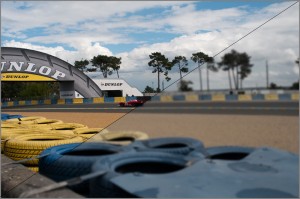
Hace tiempo realicé una entrada en mi blog dedicado a la cámara Fuji X100 y en la que trataba el tema de las distancias hiperfocales. Pues bien debido al gran número de visitas y correos recibidos, he decidido realizar esta página sobre este tema tan demandado. También es cierto que cuando imparto cursos de fotografía este tema es de los más difíciles de entender por parte de los alumnos si bien es cierto que una vez aclarado ya no se olvida.
Antes de empezar sería interesante explicar a los neófitos que es la distancia hiperfocal.
Definición de DISTANCIA HIPERFOCAL
Se denomina distancia hiperfocal de un objetivo a la mínima distancia a la que se percibe el sujeto de un modo nítido cuando el punto de enfoque del objetivo se coloca en el infinito.
Cuando se hace una foto de un paisaje enfocando al infinito se esta perdiendo la posibilidad de obtener foco en los primeros planos
Para ello lo aconsejable es conocer cual es la distancia hiperfocal de la situación concreta (objetivo utilizado, diafragma, formato del sensor) que estemos utilizando en esa toma y cambiar el enfoque a esa distancia hiperfocal. Con esto se conseguirá ampliar la zona nítida de los primeros planos.
¿Pero como se calcula esta distancia?
Cálculo de la DISTANCIA HIPERFOCAL
Se puede calcular mediante la expresión:
H = F^2 / (f * CoC)
Donde H es la distancia hiperfocal, F es la distancia focal, f es el diafragma, y CoC (Circle of Confusion) es el círculo de confusión máximo.
Se puede deducir que la distancia hiperfocal será mayor para los teleobjetivos que para los objetivos de gran angular por lo que éstos últimos tendrán una mayor profundidad de campo con carácter general. Inversamente unos números f mayores producirán una distancia hiperfocal menor y por consiguiente mayor profundidad de campo
Los círculos de confusión, un nuevo concepto, pero, ¿que es?
Definición de CÍRCULOS DE CONFUSIÓN
Se denominan «círculos de confusión» a los puntos más pequeños colocados uno junto al otro y que es posible distinguir sobre el soporte de una cámara fotográfica. Se determina el intersección de dos factores: .
La calidad (granulosidad y resolución) del apoyo de la imagen (película o captador), de una parte que fija el círculo de confusión al mínimo posible.
La claridad buscada de otra parte (función del tamaño de la tirada deseada y la distancia de observación, y también de la agudeza visual del observador…) quién fija el círculo de confusión máximo deseable.
A modo ilustrativo a continuación indicaré el tamaño de los círculos de confusión en función del tamaño del sensor:
APS-C (23,6×15,7mm) … 0,02 mm.
Full Frame (36x24mm) … 0,03 mm.
Explicación Gráfica
A continuación veremos en unos esquemas gráficos la diferencia entre enfocar al infinito y enfocar a la distancia hiperfocal. Además también se puede ver la diferencia entre utilizar un sensor full frame (36x24mm) y un sensor APS-C (23,7×15,7mm). Aprovecho también para poner antes de cada ejemplo unas tablas con las distancias hiperfocales para distintos objetivos y diafragmas realizadas para los sensores mencionados.
TABLA DE DISTANCIAS HIPERFOCALES PARA SENSOR FULL FRAME
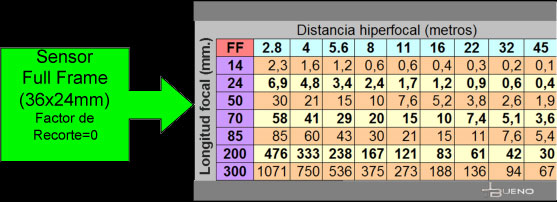
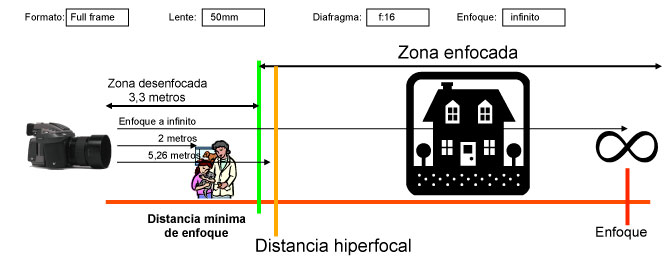
Esquema Distancia Hiperfocal con sensor FF enfocando a infinito
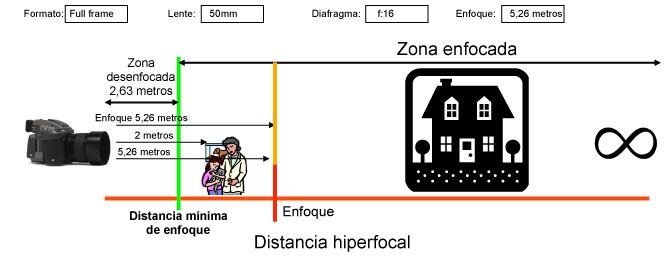
Esquema Distancia Hiperfocal con sensor FF enfocando a la hiperfocal
TABLA DE DISTANCIAS HIPERFOCALES PARA SENSOR APS-C
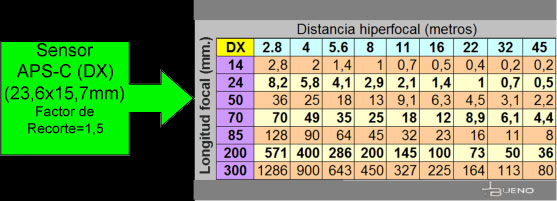
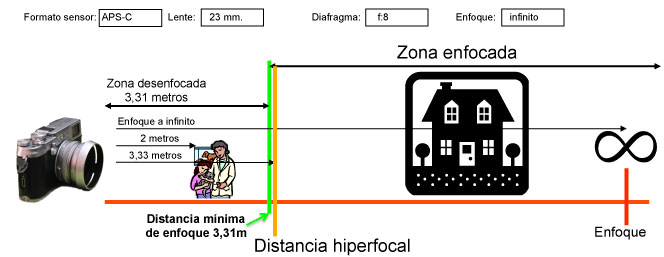
Esquema Distancia Hiperfocal con sensor APS-C enfocando a infinito
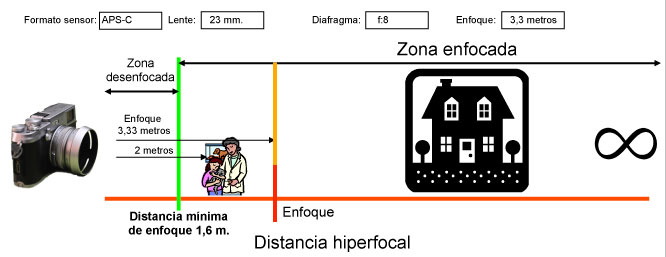
Esquema Distancia Hiperfocal con sensor APS-C enfocando a la hiperfocal
Si alguno de vosotros nunca habéis trabajado con este tipo de tablas, el método es muy sencillo. A modo de ejemplo, imaginar que hace un día soleado y por tanto estamos sobrados de luz. Si no es así no te preocupes pues podemos tirar de ISO y así conseguiremos trabajar con un diafragma bastante cerrado, por ejemplo f:16.
Siguiendo el ejemplo de la primera tabla (la de FF con un objetivo de 50mm.) y con un diafragma f:16. la distancia hiperfocal a la que deberíamos enfocar sería a 5,2 metros. De esta manera conseguiremos enfocar todo lo que esté desde 2,62m (distancia mínima de enfoque) hasta infinito.
Por el contrario, si enfocásemos a infinito aún con ese diafragma tan cerrado nuestro enfoque sería desde 3,3 metros hasta infinito por lo que se quedaría fuera de foco aproximadamente 70 centímetros. Este enfoque gratuito lo obtenemos por tan solo usar el sistema de distancias hiperfocales.
Pero … ¿cuando y como utilizar la Distancia Hiperfocal?
En mi opinión hay dos momentos en los que la utilización de la Distancia Hiperfocal es imprescindible:
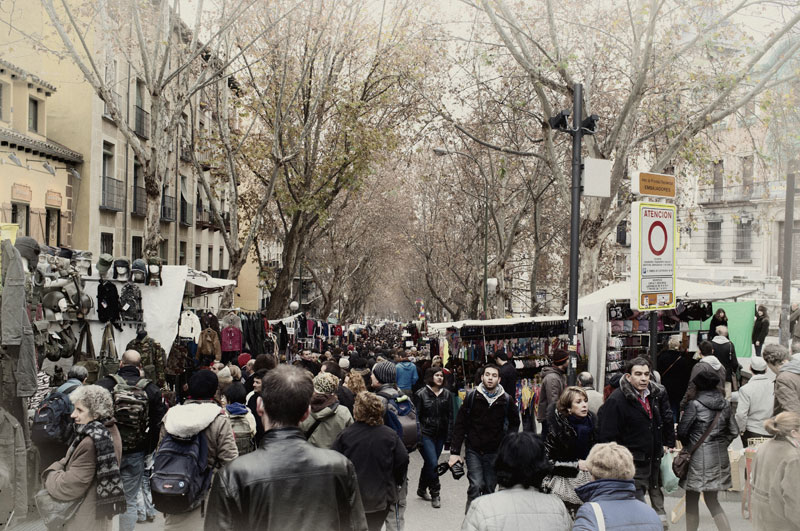
Leica M8 – Summicron 35mm. f:11 – Enfoque manual 8m. real (2,43m a infinito)
Uno es cuando decidimos utilizar nuestra cámara sin autofocus por la calle disparando a todo lo que se menea también conocido como street photografy o fotografía de la calle. Este tipo de fotografía muy divertida e interesante trata de plasmar situaciones espontáneas que se producen en lugares públicos. Quizás uno de los más famosos fotógrafos que hizo famosa esta técnica, fue Henri Cartier-Bresson que utilizaba una cámara telemétrica Leica y que evidentemente no tenía autofocus. Pues bien si queremos emular a uno de los grandes y salir a la calle dispuestos a realizar unas tomas de lo que ocurre en una ciudad y con un equipo sin autofocus no dudes es utilizar la Distancia Hiperfocal. Además cuando hacemos fotografías en mitad de esa jungla llamada ciudad, lo mejor es pasar desapercibidos y sin llamar la atención por lo que muchas tomas se realizan desde la cintura con la cámara colgada y por supuesto calculando a ojo el encuadre.
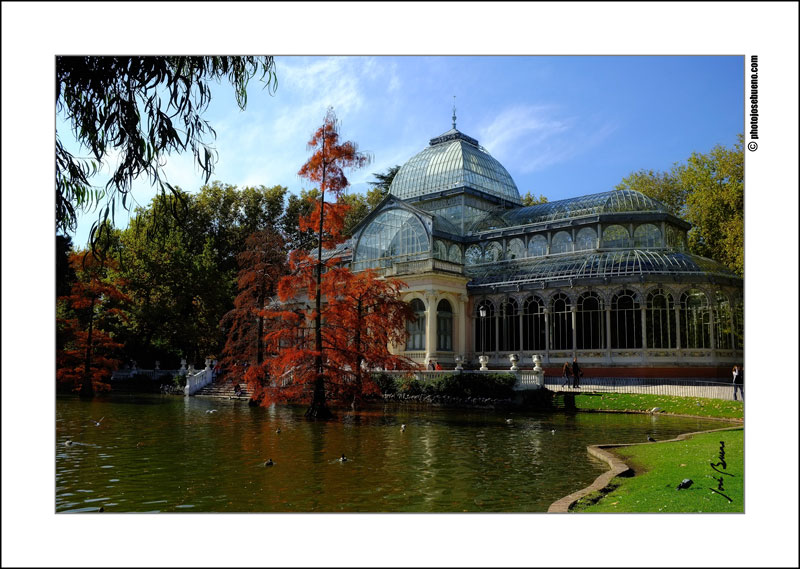
Parque del Retiro de Madrid – FujiX100 – f:8 enfoque realizado a 8m
El otro momento en el que resulta imprescindible utilizar el cálculo de la Distancia Hiperfocal es cuando queremos realizar una toma de un paisaje y tenemos elementos en los primeros planos que nos gustaría estén con la misma nitidez que aquello que está a lo que la medición de la cámara llama infinito. En ese caso también tenemos otro maestro al que admiro profundamente y que utilizaba este método, me estoy refiriendo al fotógrafo Amsel Adams, todo un genio a la hora de manejar el enfoque y desenfoque en paisajes.
Pero no solo podremos utilizar la hiperfocal en fotos al infinito, también es muy interesante utilizarla en primeros planos. Un ejemplo es la imagen en la que aparece un agente de movilidad, en esta ocasión llevaba la Leica M8 con un Summicron 35mm, lógicamente con enfoque manual por lo que coloqué el diafragma en f:8 y la distancia a 4 metros, esto según los cálculos deberá enfocar a todo lo que esté entre el rango de 2,51 metros y hasta 9,89 metros por lo que tan solo tuve que parar un segundo para evitar una foto movida y encuadrar a ojo con la cámara situada en la cintura. El resultado prefiero que lo juzgues tu mismo.
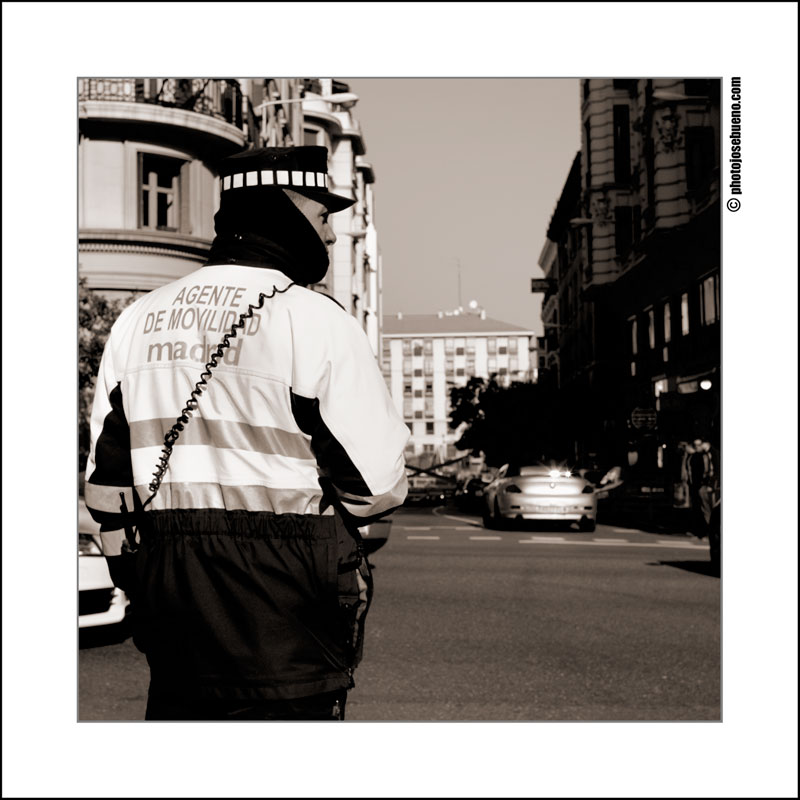
Agente de movilidad de Madrid – Leica M8 – Summicron 35mm – f:8 – enfoque manual a 4 metros
Si te has dado cuenta, en ambas situaciones lo normal el utilizar objetivos angulares, tanto para la street photografy como para el paisaje y es que cuanto mayor ángulo recoja nuestro objetivo mayor profundidad de campo y por lo tanto mejor para realizar imágenes con el cálculo hiperfocal.
Si tu cámara y objetivo es autofocus, no olvides dejar el enfoque en manual para que no cambie cuando pulsemos el disparador.
Espero que con esta explicación te haya quedado más claro este tema tan interesante y que gracias a la red cada día es más conocido. De hecho existen páginas donde puedes calcular la distancia hiperfocal en función incluso del modelo de tu cámara aunque esto es tan solo para saber la medida del sensor. También puedes encontrar aplicaciones que hacen el cálculo en tu teléfono móvil pero mi consejo es que si te aprendes un par de distancias hiperfocales para diafragmas «interesantes» como f:8 y f:11 Es suficiente para salir del paso. Y, ¿porqué esos diafragmas son interesantes? pues porque con diafragmas más abiertos hay poca profundidad de campo y con diafragmas más cerrados aparece la famosa aberración cromática.
Pero si alguna ves estas en mitad del desierto con tu cámara y quieres sacar la foto de tu vida con las dunas de fondo y tu camello en primer plano pero no recuerdas la dichosa Distancia Hiperfocal ni tienes cobertura para consultar por Internet, lo mejor que puedes hacer es utilizar las olvidadas escalas de profundidad de campo que vienen en los objetivos aunque es cierto que cada vez los fabricantes se molestan menos en ponerlas. Además les voy a dar una idea gratuita: Señores fabricantes ya que cada vez se molestan menos e incluir las escalas de la profundidad de campo porqué no incluyen un pequeño programa que facilite en pantalla la Distancia Hiperfocal, es muy sencillo y seguro que más de uno se lo agradecería.
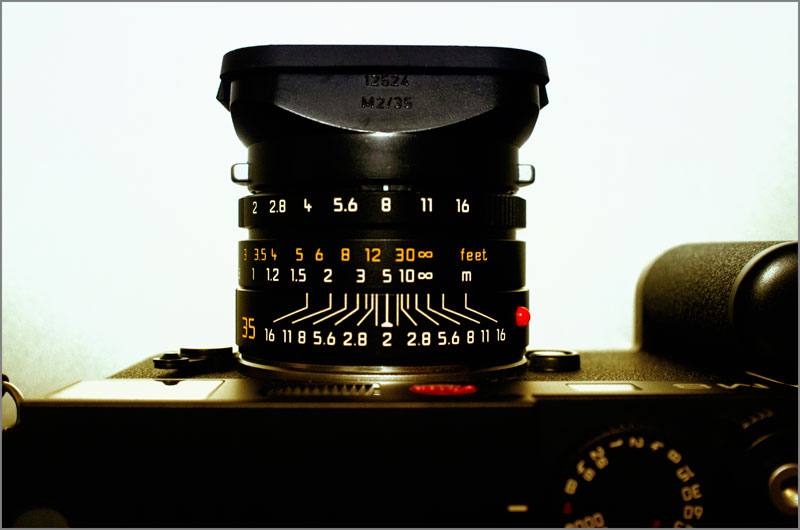
Retomando el tema de como salir del paso y hacer la foto del camello y las dunas con todo enfocado, si miramos la escala de profundidad de campo, ésta nos dará una buena aproximación de enfoque hiperfocal. ¿Cómo? pues muy sencillo, si observamos dicha escala en la foto del Leica Summicron 35mm. veremos que en lugar de enfocar a infinito hemos enfocado a 5 metros con un diafragma f:8 por lo que en nuestra foto saldrá nuestro camello situado a 2,5 metros y las dunas del fondo. Esto es aproximado pues en este caso las escalas están hechas para un formato full frame. Si nuestra cámara tiene un sensor menor no te preocupes pues a menos sensor mayor profundidad de campo y es que los círculos de confusión varían.
En los cálculos que se pueden obtener en Internet, también suelen facilitar la distancia de enfoque mínima y máxima pero esto también lo pues obtener de manera muy aproximada con la escala de la profundidad de campo del objetivo.
Por cierto espero que la foto del camello y las dunas al menos te haya quedado bien pero no olvides nunca que lo importante es salir del desierto vivo.
Some time ago I did a post on my blog dedicated to the Fuji X100 camera and which was the subject of hyperfocal distances. Well because of the large number of visits and emails received, I decided to make this site about this topic as defendant. It is also true that when photography courses impart this topic is the most difficult to understand by students if it is true that once it was clear and not forgotten.
Before you start it would be interesting to explain to the uninitiated that is the hyperfocal distance.
Defining hyperfocal distance
It’s called hyperfocal distance of a target at the minimum distance at which the subject perceives a clear way when the lens focus point is placed at infinity.
When taking a picture of a landscape focusing to infinity are missing the opportunity to gain focus in the foreground
To do this it is advisable to know what is the hyperfocal distance of the specific situation (lens used, aperture, sensor format) that we are using in the intake and change the focus to the hyperfocal distance. This will be achieved by expanding the area clear of the limelight.
But how to calculate this distance?
Hyperfocal distance calculation
It can be calculated by the expression:
H = F^2 / (f * CoC)
Where H is the hyperfocal distance, F is the focal length, f is the diaphragm, and CoC is the maximum circle of confusion.
It can be deduced that the hyperfocal distance will be greater for telephoto lenses than for wide-angle lenses so that the latter will have a greater depth of field in general. Conversely a higher f numbers hyperfocal distance will produce a smaller, and thus greater depth of field
The circles of confusion, a new concept, but what is it?
Definition of circles of confusion
They are called «circles of confusion» to the smaller dots placed next to each other and that can be distinguished on the support of a camera. Determining the intersection of two factors.
The quality (graininess and resolution) of the support of the image (film or sensor), a party setting the circle of confusion to a minimum.
Clarity sought from elsewhere (depending on the size of the desired roll and the viewing distance, and visual acuity of the observer …) who sets the desired maximum circle of confusion.
To illustrate below will indicate the size of the circles of confusion based on the size of the sensor:
APS-C (23,6 x15, 7mm) … 0.02 mm.
Full Frame (36x24mm) … 0.03 mm.
Explanation Graphics
Then we will see in a graphic schemes the difference between focus and focus to infinity hyperfocal distance. In addition you can also see the difference between using a full frame sensor (36x24mm) and APS-C (23.7 x15, 7mm). I also take to put before each sample tables with hyperfocal distance for different lenses and diaphragms made for the sensors mentioned.
If any of you have never worked with this type of tables, the method is very simple. As an example, imagine a sunny day and are therefore light sobrados. If not do not worry because we can pull ISO and so get to work with a fairly closed aperture, say f: 16.
Following the example of the first table (the FF with a 50mm lens.) And a diaphragm f: 16. hyperfocal distance at which we should be focusing to 5.2 meters. Thus, we achieve focus everything from 2.62 m (minimum focusing distance) to infinity.
Conversely, if even infinity enfocásemos diaphragm so closed that our approach would be from 3.3 meters to infinity so would be out of focus is approximately 70 centimeters. This approach we get it free for only using the system hyperfocal distances.
But … When and how to use the hyperfocal distance?
In my opinion there are two times when the use of the hyperfocal distance is essential:
One is when we decided to use our camera without autofocus down the street shooting at anything that wiggles photografy aka street or street photography. This type of photography is very fun and interesting to capture spontaneous situations that occur in public places. Perhaps one of the most famous photographers who made this technique famous was Henri Cartier-Bresson who used a Leica rangefinder camera and obviously did not have autofocus. Well if we want to emulate one of the great and go out prepared to make some shots of what happens in a city and a team without autofocus please use the hyperfocal distance is. Also when photographs do half of that jungle called city, it is best to lay low and not draw attention to what many shots are taken from the waist with the camera around and of course calculating eye to the frame.
The other time when it is essential to use the hyperfocal distance calculation is when we want to take a shot of a landscape and there are elements in the foreground that we would be with the same sharpness as what is to what measurement camera called infinite. In that case we have another teacher whom I admire deeply and he used this method, I am referring to the photographer Amsel Adams, a genius when it comes to managing landscapes focus and blur.
Not only can we use the hyperfocal on photos to infinity, is also very interesting to use in close-ups. An example is the image that appears on a mobility agent, this time wearing the Leica M8 with Summicron 35mm manual focus logically placed so that the diaphragm in f: 8 and 4 meters distance, this according to the calculation must focus on everything from the range of 2.51 meters to 9.89 meters so only had to stop a second to avoid a blurred picture and frame to eye with the camera on the waist. The result prefer to judge it yourself.
If you noticed, in both normal situations the use wide-angle lenses for both street photografy to the landscape and the larger angle is that our goal collect greater depth of field and therefore better for images with calculating hyperfocal .
If your goal is autofocus camera and do not forget to leave the manual approach that does not change when you press the shutter.
I hope this explanation will have become clearer this very interesting and thanks to the network every day is better known. In fact there are sites where you can calculate the hyperfocal distance depending on your model even though this camera is just to know the extent of the sensor. You can also find applications that do the calculations on your mobile phone but my advice is that if you learn a few diaphragms hyperfocal distances for «interesting» f: 8 f: 11 is enough to get by. And, why these diaphragms are interesting? Because there are more open-fitted shallow depth of field and more closed aperture appears the famous chromatic aberration.
But if you see these in the middle of the desert with your camera and want to take a picture of your life with dunes background and your camel in the foreground but not recall the happy hyperfocal distance or have coverage available on the Internet, the best you can neglected to do is use the depth of field scales that come in the objectives but it is true that manufacturers increasingly less bother them. Also I’ll give an idea free: Lords manufacturers as more and less bother scales and include depth of field why not include a small program that facilitates the hyperfocal distance on screen, is very simple and certainly more than one I’d appreciate it.
Returning to the issue of how to get out of the way and take the picture of the camel and the dunes with everything in focus, looking at the depth of field scale, this will give us a good approximation hyperfocal focusing. How? It’s simple, if you look at the scale on the Leica Summicron 35mm photo. see that instead of focusing to infinity we have focused on five meters with a diaphragm f: 8 as in our picture will our camel situated 2.5 meters deep dunes. This is approximate because in this case the scales are made for a full frame format. If your camera has a smaller sensor not worry unless sensor for greater depth of field and the circles of confusion vary.
In the calculations that can be obtained on the Internet, also often provide minimum focus distance and maximum but also because it get very rough with the scale of the depth of field of the lens.
By the way I hope the picture of the camel and the dunes at least you have been good but never forget that the important thing is to get out of the desert alive.
Hola Jose
Muy bien explicado y con buenos ejemplos, lo has hecho muy fácil de entender para todos.
Animo, sigue compartiendo tus grandes conocimientos.
Chema.
Estoy impresionado de http://www.photojosebueno.com, tengo que decir. Muy a menudo no me encuentro con un blog que cada educativa y entretenida, y déjeme informarle, tienes puesto el dedo en la cabeza. Su concepto es excepcional, la dificultad es una cosa que no suficientes personas están hablando inteligentemente sobre. Estoy muy feliz de que me encontré con todo esto en mi busca para algo respecto a esto.
Muchas gracias por tus comentarios. Esto me anima a seguir con más fuerza
An interesting discussion is worth comment. I think that you should write more on this topic, it might not be a taboo subject but generally people are not enough to speak on such topics. To the next. Cheers
Thank you very much
Hello.This artículo fue muy interesante , sobre todo porque yo estaba buscando ideas sobre este asunto último par de días. los mejores deseos
You have made some good points there. I checked on the web for more information about the issue and found most individuals will go along with your views on this web site.
Thank you very much
Good ?V I should certainly pronounce, impressed with your site. I had no trouble navigating through all tabs and related information ended up being truly easy to do to access. I recently found what I hoped for before you know it at all. Quite unusual. Is likely to appreciate it for those who add forums or anything, web site theme . a tones way for your client to communicate. Excellent task..
Thank you very much
Algunos de los puestos de elección genuinamente en este sitio , guardar en fav . 😉 😉
Pingback: luottoa
Pingback: blog-blogs
Pingback: Payday loans
Pingback: Payday Loans